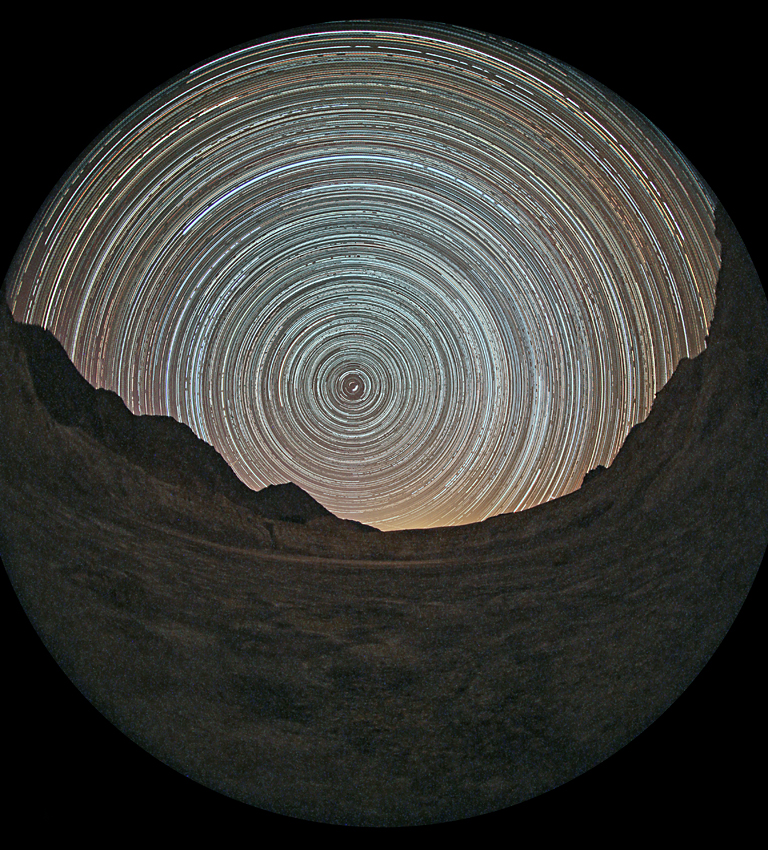
One of the most basic types of astrophotography and yet equally stunning is that involving star trails, particularly
around the celestial poles or immediately due east or west. In addition to capturing the motion of stars around the
north pole which are circumpolar and, hence, never rise or set, we also have the ability to capture seasonal
constellations and stars in such photos, thus allowing for different opportunities during different seasons. Star trail
photos also provide direct evidence that our planet rotates and does so at a rate of 15° per hour. Furthermore, by
studying the arc for a particular star, especially as far away from the pole as possible, one can indirectly estimate
the length of the (total) exposure which often ranges from seven to eight hours in duration and is totally dependent
on the end of astronomical twilight one evening and its onset
the following morning.
Many star photos are centered on Polaris, a double star system which represents our quickest means to locating the
north celestial pole, for it lies less than 1.0° from it, and is an excellent starting point for the polar alignment
of a telescope (and finding your way home if you are lost!). Due to the extended length of the typical exposures
involved, the best film for such work is Kodak Elite Chrome (ISO 100) whose reciprocity failure is nearly zero or
Fujichrome Velvia and Provia (ISO 50 and 100) emulsions with equally impressive curves! With respect to equipment, it
is rudimentary, for a camera with extended exposure capibility is required along with a firm tripod and shutter
release and locking cable. It is also preferable that the camera used have a mechanical shutter so that battery
consumption and power does not become an issue during mid-exposure. The final requirement is a location with dark
skies - the darker the better so that the trails and their colouration will be as bright and contrasty as possible -
with, preferably, an interesting foreground which can be used to enrich the final result.
Note: Greece is amongst the top ten seismogenic countries in the world and it is no
surprise that some very dramatic volcanoes and calderas grace some of the Greek islands. One of the most impressive
remnants of seismologic activity is the active volcano on the island of Nisyros in the eastern Aegean located northwest
of Rhodes and south of Kos. More specifically, Nisyros is the cone remnant of the volcano with the collapsed caldera
floor sitting virtually at the center of the island and between the small towns of Mandraki to the northwest and Nikia
to the southeast with the latter gracing the southern caldera rim. One characteristic of the immediate area are the
smoking fumaroles where sulphur is brought onto the surface as well as many hot natural spas in the general vicinity.
Stefanos crater, measuring 300 meters in diameter and approximately 27 meters in depth, represents the primary and deepest
point of interest of the four kilometer-wide ellipsoid caldera. The loose and soft rock formations of Stefanos crater erode
easily during rainfall and which suggests the crater to be 3,000 to 4,000 years old. In contrast, the (still active) volcano
is believed to be approximately 150,000 years old and with four eruptive stages to-date. The volcano at Nisyros forms part
of the volcano arch which begins west of Athens (at Methana) and goes through Milos, Santorini and finally terminates at Nisyros.
|
Proper Star Name: Polaris Bayer Letter: á Ursae Minoris Tycho Catalog: TYC 4628-237-1 SAO Catalog: SAO 308 Luminosity 2290 +/- 282 x Sun Distance: 431 +/- 26 light yrs RA / Dec: 02h 39m 31s / +89° 17' 39" B-V Color Index: +0.570 mag Magnitude: 1.98 |
 |
Date: July 10-11, 2018 22:07 - 4:02 UT+3 Location: Stefanos Crater, Nisyros, Greece Equipment: Canon EOS 6D Baader BCF2 Filter Peleng 8mm/f3.5 @ f8.0 Exposures: 355 min (176 x 120 sec) (RGB) 010 min (005 x 120 sec) (Dark) ISO 1000 JPG Fine Image Format 5472x3648 Image Size Custom White Balance Manual Mode Continuous Servo Mode Software: Startrails V2.3 Photoshop CS5 Processing: Dark Frame Reduction Layers and Lighten Resampling Unsharp Masking JPG Compression |